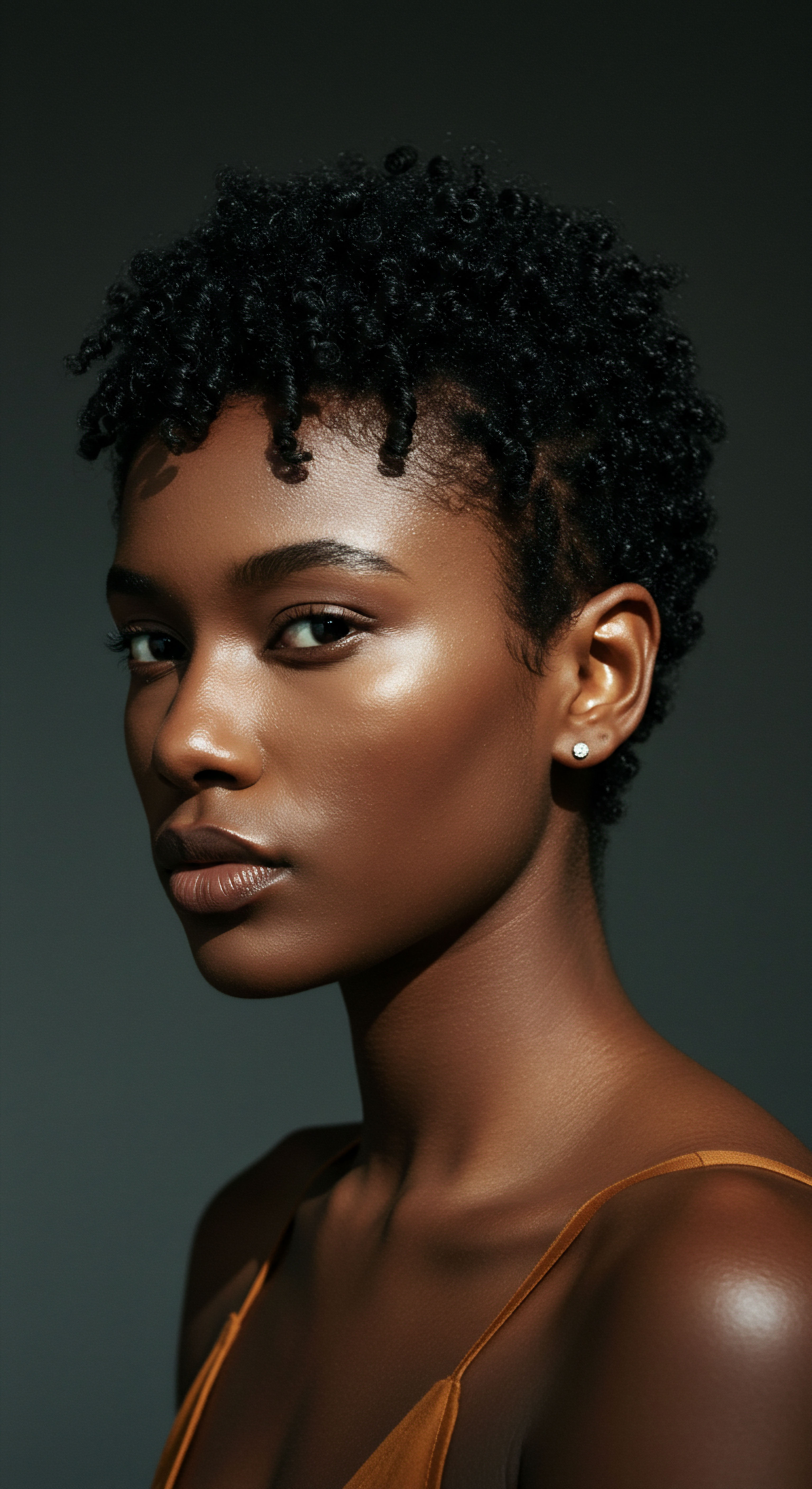
Roots
The gentle hush of night often brings with it a promise of renewal, a quiet unfolding that reaches into every corner of our being. For those with textured hair, particularly the magnificent coily strands, this nightly period holds a potential for deep restoration that extends beyond simple rest. We often think of hair care as a daytime pursuit—the cleansing, the conditioning, the careful styling—yet, what transpires while we sleep can be just as significant, if not more so, for the strength and resilience of our coils. This exploration delves into the foundational connections between consistent, profound sleep and the intrinsic health of hair, uncovering how the body’s nocturnal rhythms play a quiet yet powerful role in the vitality of each strand.
Our hair, far from being inert, is a living extension, a testament to the body’s constant state of activity. Its health begins at the scalp, within the hair follicles themselves. These tiny organs are not merely passive producers of hair; they are dynamic centers of cellular activity, constantly cycling through phases of growth, transition, and rest. Understanding these underlying biological rhythms helps us appreciate the intricate dance that supports strong, vibrant coils.
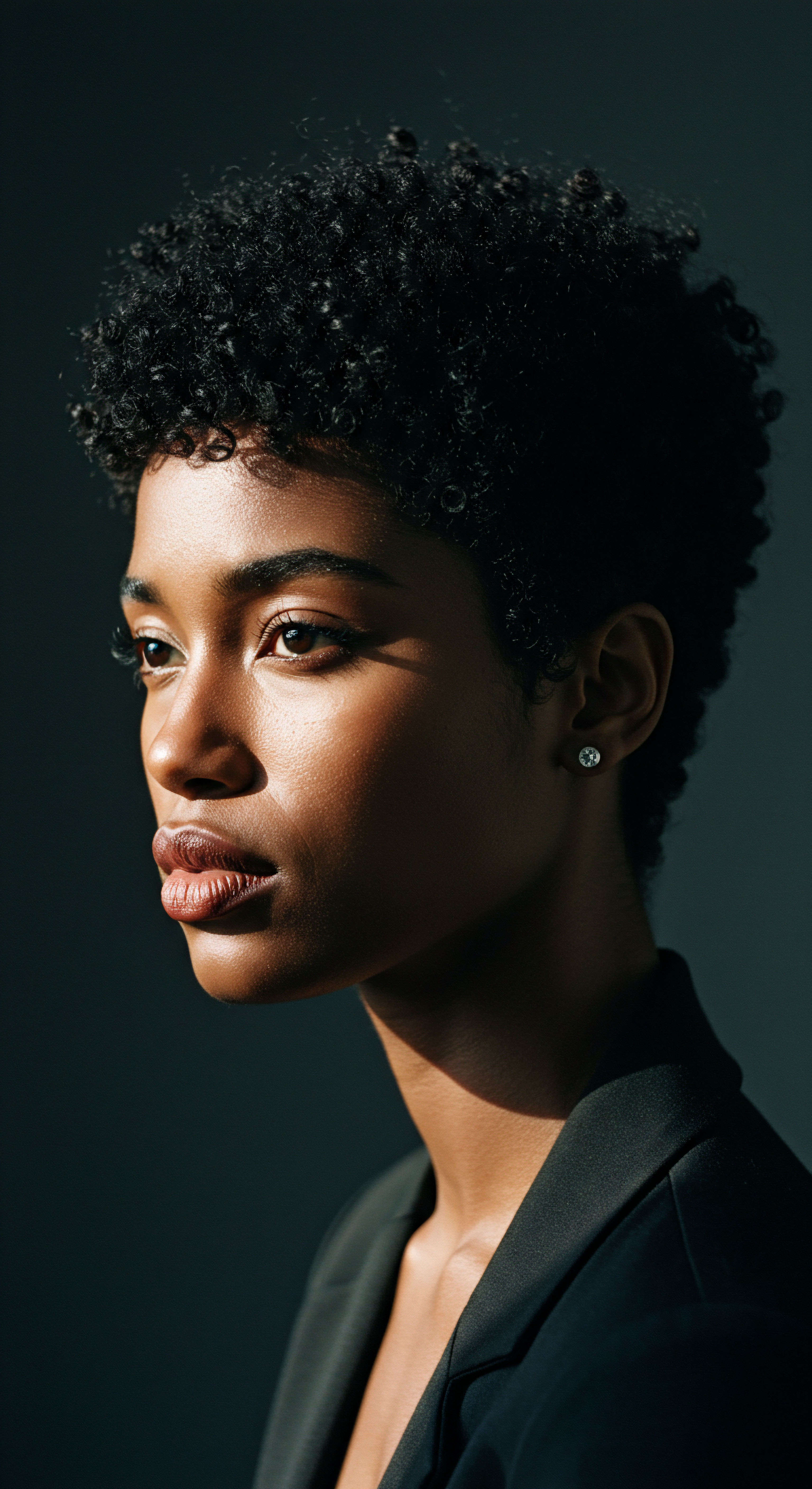
The Hair Follicle and Its Rhythms
Each hair on our head emerges from a structure called the hair follicle, nestled just beneath the skin’s surface. These follicles are miniature factories, meticulously crafting each strand. They possess their own internal timing mechanisms, often referred to as peripheral circadian clocks.
These biological clocks within the hair follicles themselves regulate various physiological processes, including hair growth and pigmentation. The cycle of hair growth consists of three main phases:
- Anagen ❉ This is the active growth phase, where hair cells rapidly divide and a new hair shaft is produced. It can last for several years.
- Catagen ❉ A brief transitional phase where hair growth slows, and the follicle begins to shrink.
- Telogen ❉ The resting phase, where hair stops growing and eventually sheds, making way for new growth.
These cycles are not isolated events; they are profoundly influenced by the body’s overarching circadian rhythm, which is the natural, internal process that regulates the sleep-wake cycle over approximately 24 hours. When this rhythm is disrupted, it can send ripples through the entire system, including the delicate processes occurring within the hair follicles. Research indicates that circadian clock genes are expressed heterogeneously in hair follicles and can be modulated by both the central circadian system and external factors.

What Happens to Hair During Sleep
Sleep, particularly its deeper stages, is a period of intense cellular repair and regeneration for the entire body, and hair is no exception. During these hours of rest, the body dedicates resources to healing and rebuilding. This restorative activity is crucial for maintaining the integrity of hair proteins and the overall health of the scalp.
Blood flow to the scalp increases during deep sleep, delivering essential nutrients and oxygen directly to the hair follicles. This nourishment is vital for the hair-producing cells to operate optimally, providing the building blocks necessary for robust hair growth. Additionally, important hormones, such as growth hormone and melatonin, are released during sleep. Growth hormone stimulates cell regeneration, supporting hair follicle activity, while melatonin, known for regulating sleep, also plays a role in synchronizing hair cycle timing and has antioxidant properties that can help protect hair follicles from damage.
The nightly embrace of sleep offers a quiet, profound restoration for coily strands, reaching deep into the hair follicle’s intrinsic rhythms.
Consider the skin itself, which is intrinsically linked to scalp health. Studies show that during sleep, skin cells undergo intensive repair and regeneration, with processes like collagen production increasing. A compromised skin barrier due to lack of sleep can lead to increased water loss and decreased hydration, affecting the scalp and, by extension, the hair. The integrity of the scalp’s skin barrier is just as vital as the hair itself for maintaining a healthy environment for growth.

Ritual
Moving from the foundational understanding of hair’s biology, we now turn to the practical wisdom that emerges when we consider the query ❉ Can consistent deep sleep improve the strength of coily strands? This section explores how integrating conscious nighttime practices with the body’s natural restorative processes can yield tangible benefits for textured hair. It is a space where the science of rest meets the art of care, offering gentle guidance on how to create a nightly sanctuary for your coils.
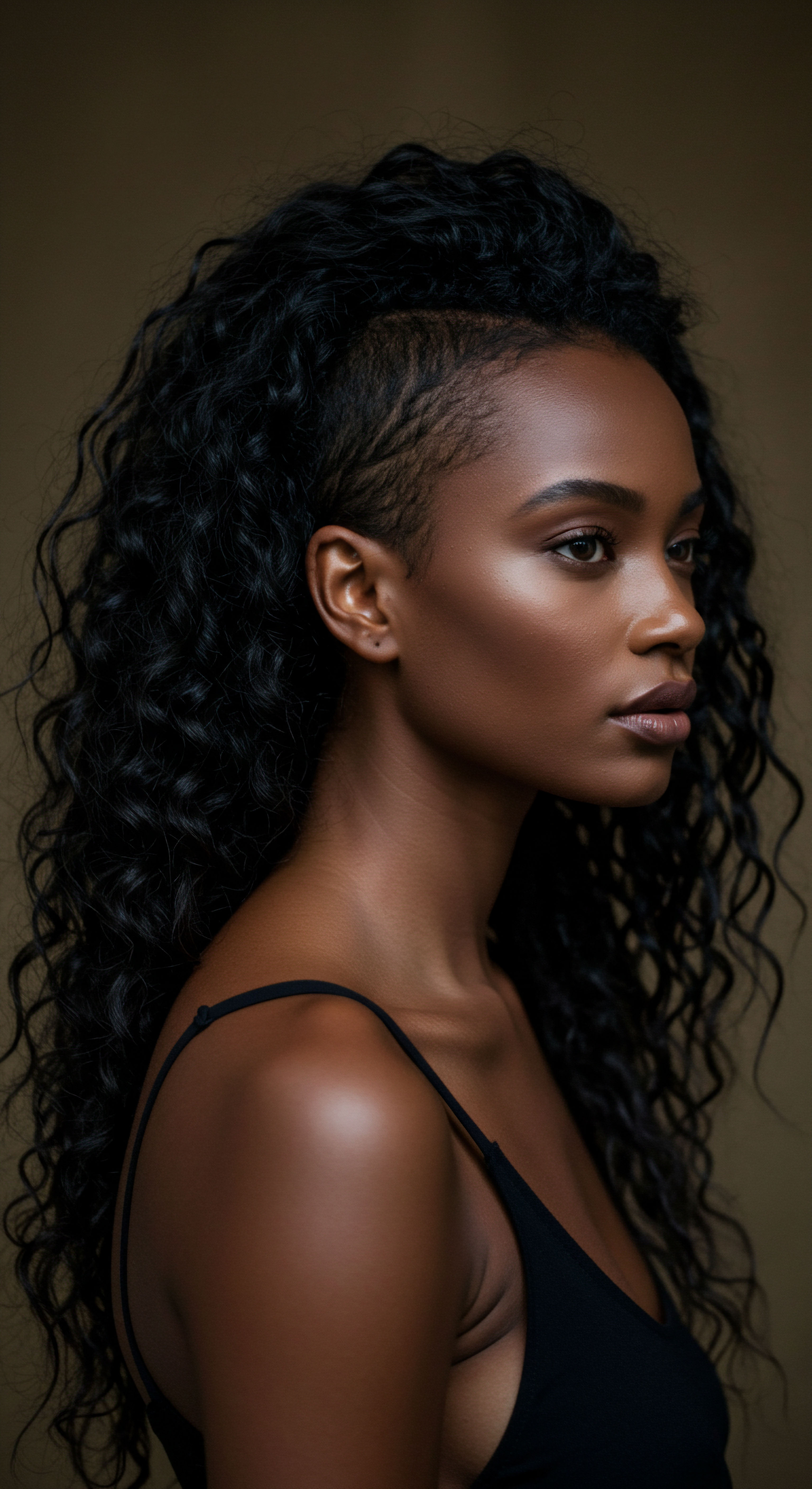
Crafting a Nighttime Sanctuary for Coils
The idea of “beauty sleep” holds more truth than often acknowledged, particularly for coily hair, which is inherently more prone to dryness and breakage due to its structure. The friction against rough surfaces during sleep can lead to tangles, frizz, and mechanical damage. Establishing a deliberate nighttime ritual can significantly mitigate these challenges, working in concert with the body’s restorative cycles.
A key component of this ritual involves protecting the hair from external stressors while you sleep. Traditional practices across many cultures have long recognized the protective qualities of wrapping or covering hair at night. This wisdom finds modern resonance in the use of silk or satin materials.
| Material Type Cotton Pillowcases |
| Hair Benefits Breathable |
| Considerations High friction, absorbs moisture from hair, can cause frizz and breakage. |
| Material Type Silk Pillowcases |
| Hair Benefits Low friction, retains hair moisture, reduces tangles and frizz. |
| Considerations Higher cost, requires delicate care. |
| Material Type Satin Pillowcases |
| Hair Benefits Low friction, retains hair moisture, reduces tangles and frizz. |
| Considerations More affordable than silk, durable. |
| Material Type Silk or Satin Bonnets |
| Hair Benefits Comprehensive protection, retains moisture, minimizes friction from all angles. |
| Considerations Requires consistent use, may feel restrictive to some. |
| Material Type Selecting the right sleep surface can significantly reduce mechanical stress on coily strands. |

The Wisdom of Bonnets and Wraps
For coily hair, a silk or satin bonnet, scarf, or pillowcase acts as a shield. The smooth surface allows strands to glide rather than snag, preventing the microscopic tears that weaken hair over time. Beyond preventing mechanical damage, these materials also help retain the hair’s natural moisture, which is especially vital for coily textures that are prone to dehydration. Cotton, by contrast, absorbs moisture, drawing it away from your hair as you sleep, leading to drier, more brittle strands upon waking.
Deliberate nighttime care, particularly with silk or satin protection, safeguards coily hair from mechanical damage and moisture loss during sleep.
The choice of material and method becomes a personal preference, but the underlying principle remains constant ❉ minimize friction and preserve moisture. Whether it is a bonnet, a wrap, or simply a smooth pillowcase, this conscious decision creates an environment where your hair can truly benefit from the body’s natural nightly repair processes. It is a gentle yet powerful act of care that supports the physical integrity of each coil, allowing the hair to maintain its strength and elasticity.

Nighttime Hydration and Styling
Beyond physical protection, nighttime can also be an opportune time for hair hydration and gentle styling. Applying a light leave-in conditioner or a hydrating serum before bed can help seal in moisture, allowing the products to work undisturbed as you sleep. For those who prefer to preserve a particular style, gentle twists or braids before covering the hair can help maintain definition and prevent tangling, reducing the need for excessive manipulation in the morning.
- Moisture Application ❉ Gently apply a hydrating leave-in or light oil to strands before bed to replenish moisture lost throughout the day.
- Protective Twisting ❉ Section hair into large, loose twists or braids to prevent tangling and maintain stretched length, reducing manipulation upon waking.
- Scalp Attention ❉ A gentle scalp massage can increase circulation, supporting the hair follicles as they undergo their nightly repair processes.
These deliberate steps contribute to an overall regimen that acknowledges the importance of the sleep period for hair health. By setting the stage for rest and recovery, we are not only preserving our hair but actively participating in its renewal.

Relay
To truly grasp the intricate interplay between consistent, deep sleep and the resilience of coily strands, we must venture beyond surface-level observations. The question of whether sleep strengthens hair invites a deeper, more reflective inquiry, one that connects the quiet mechanics of our rest to the profound biological and even cultural narratives surrounding textured hair. This section moves into a sophisticated exploration, drawing upon scientific findings and the interconnectedness of our biological systems to illuminate the profound impact of nocturnal rest.
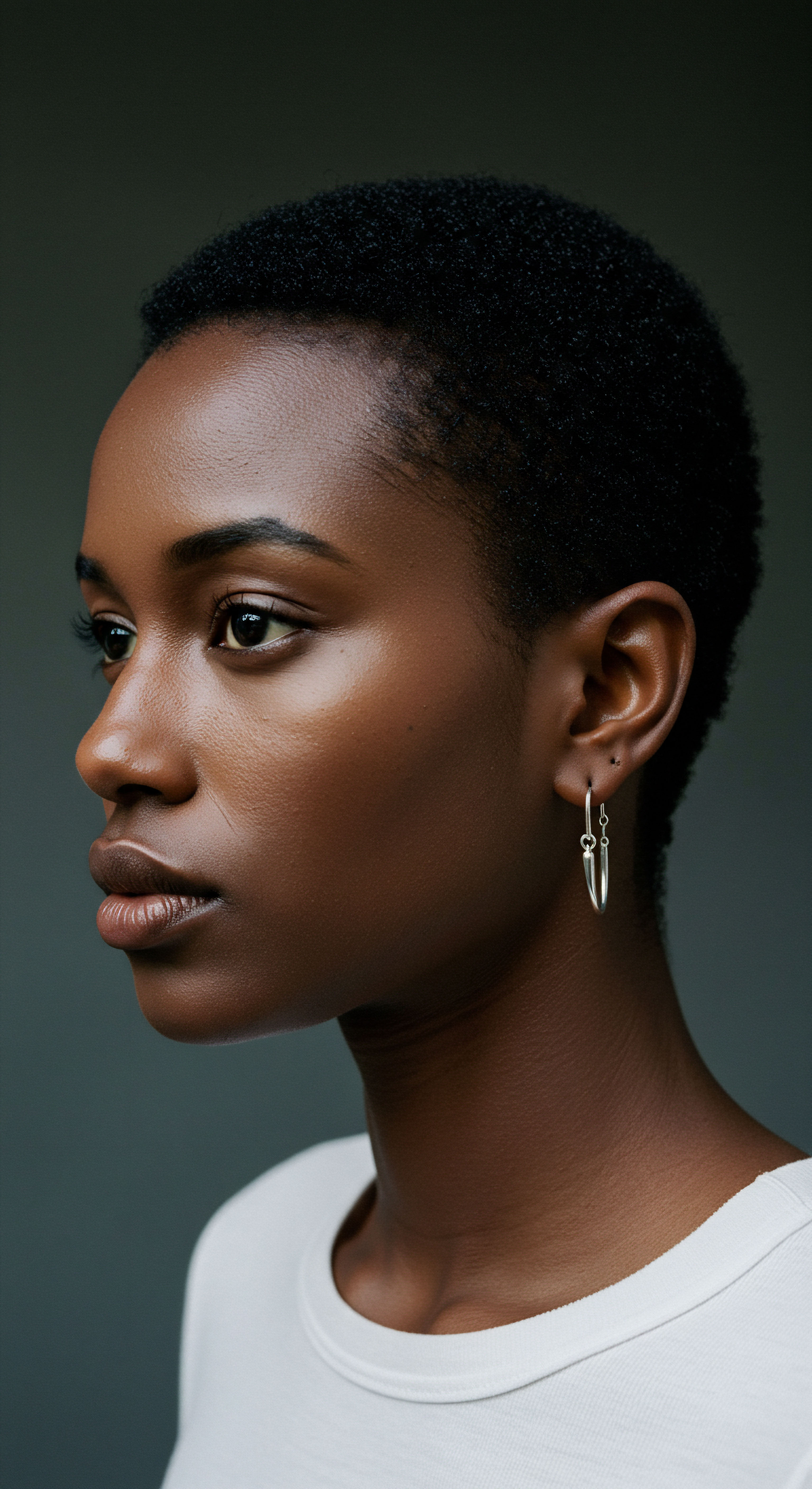
How Does Sleep Aid Cellular Repair in Hair Follicles?
The hair follicle, a dynamic mini-organ, orchestrates the complex dance of hair growth. During deep sleep, particularly the non-REM stages, the body shifts into a repair and growth mode. This period is marked by an increase in cellular turnover and tissue repair.
Crucially, it is during these restorative sleep phases that the body produces growth hormones, which are essential for stimulating cell regeneration and promoting hair follicle growth. These hormones facilitate the reproduction and regeneration of cells, including those responsible for building hair strength.
Beyond growth hormones, sleep also influences other biological mechanisms pertinent to hair strength. Melatonin, the hormone primarily associated with sleep regulation, also exhibits antioxidant properties that can protect hair follicles from oxidative stress and environmental damage. Furthermore, melatonin receptors have been identified in human hair follicles, suggesting a direct role in synchronizing the hair cycle.
Deep sleep initiates a cascade of cellular repair and hormonal releases, directly supporting the vitality and growth of hair follicles.

Can Disrupted Sleep Cycles Weaken Hair Structure?
Disruptions to our sleep cycles can indeed have tangible consequences for hair health. When sleep is consistently inadequate or fragmented, the body’s ability to perform its nightly repair functions is compromised. This can lead to a reduction in the synthesis of proteins vital for hair structure, such as keratin, which is the primary protein component of hair.
One often overlooked consequence of poor sleep is its impact on the body’s stress response system. Chronic sleep deprivation elevates cortisol levels, the body’s primary stress hormone. Elevated cortisol can trigger inflammation and has been linked to conditions that accelerate hair shedding, such as telogen effluvium, where hair follicles are prematurely pushed into a resting phase.
A compelling study, though not directly on coily hair, offers a significant data point regarding the impact of sleep deprivation on hair protein synthesis. In a 1980 study published in the Journal of Investigative Dermatology, researchers observed a 19% decrease in beard-hair growth in ten young men who underwent 48 hours of sleep deprivation. This observed reduction was attributed to a lowering of protein synthesis during sleep deprivation, potentially related to hormonal disturbances, including a depression of growth hormone release.
While this study focuses on beard hair and is older, it provides a foundational insight into the direct physiological impact of sleep deprivation on hair’s protein-building capacity, a mechanism directly relevant to the structural integrity of all hair types, including coily strands. The findings underscore the body’s holistic response to sleep quality, suggesting that a lack of adequate rest can indeed hinder the very building blocks of hair.
| Physiological Process Cellular Regeneration |
| Impact of Adequate Sleep Increases cell turnover and repair, especially in hair follicles. |
| Consequence of Poor Sleep Impaired repair, weaker hair follicles. |
| Physiological Process Hormone Regulation |
| Impact of Adequate Sleep Optimizes release of growth hormone and melatonin, supporting hair cycle. |
| Consequence of Poor Sleep Disrupted hormone balance, slowed hair growth, increased shedding. |
| Physiological Process Blood Circulation |
| Impact of Adequate Sleep Enhances blood flow to the scalp, delivering nutrients. |
| Consequence of Poor Sleep Reduced circulation, nutrient deprivation for follicles. |
| Physiological Process Stress Response |
| Impact of Adequate Sleep Lowers cortisol levels, reducing inflammation and premature shedding. |
| Consequence of Poor Sleep Elevated cortisol, increased inflammation, potential telogen effluvium. |
| Physiological Process Protein Synthesis |
| Impact of Adequate Sleep Supports the building of structural proteins like keratin. |
| Consequence of Poor Sleep Decreased protein synthesis, weaker hair structure. |
| Physiological Process The body's nocturnal activities directly influence hair health, emphasizing the need for consistent, restorative sleep. |

Considering the Hair’s Biological Clock
The hair follicle itself possesses a circadian clock, an internal timer that influences its growth cycle. This means that hair cells have an optimal time for growth and repair. When our sleep-wake cycles are misaligned with this natural rhythm, it can throw the hair’s own biological clock out of sync. Research has shown that clock genes, such as BMAL1 and PER1, play roles in regulating the hair follicle cycle, and disruptions to these genes can affect the progression of hair growth phases.
For coily hair, which can be more susceptible to environmental stressors and styling manipulation, this internal synchronization becomes even more pertinent. A well-rested body, operating in harmony with its circadian rhythms, creates an optimal internal environment for hair cells to regenerate, strengthen, and maintain their unique helical structure. This deeper connection between our sleep patterns and the very molecular machinery of hair growth underscores why consistent, profound sleep is not merely a luxury, but a biological imperative for truly strong and vibrant coily strands.
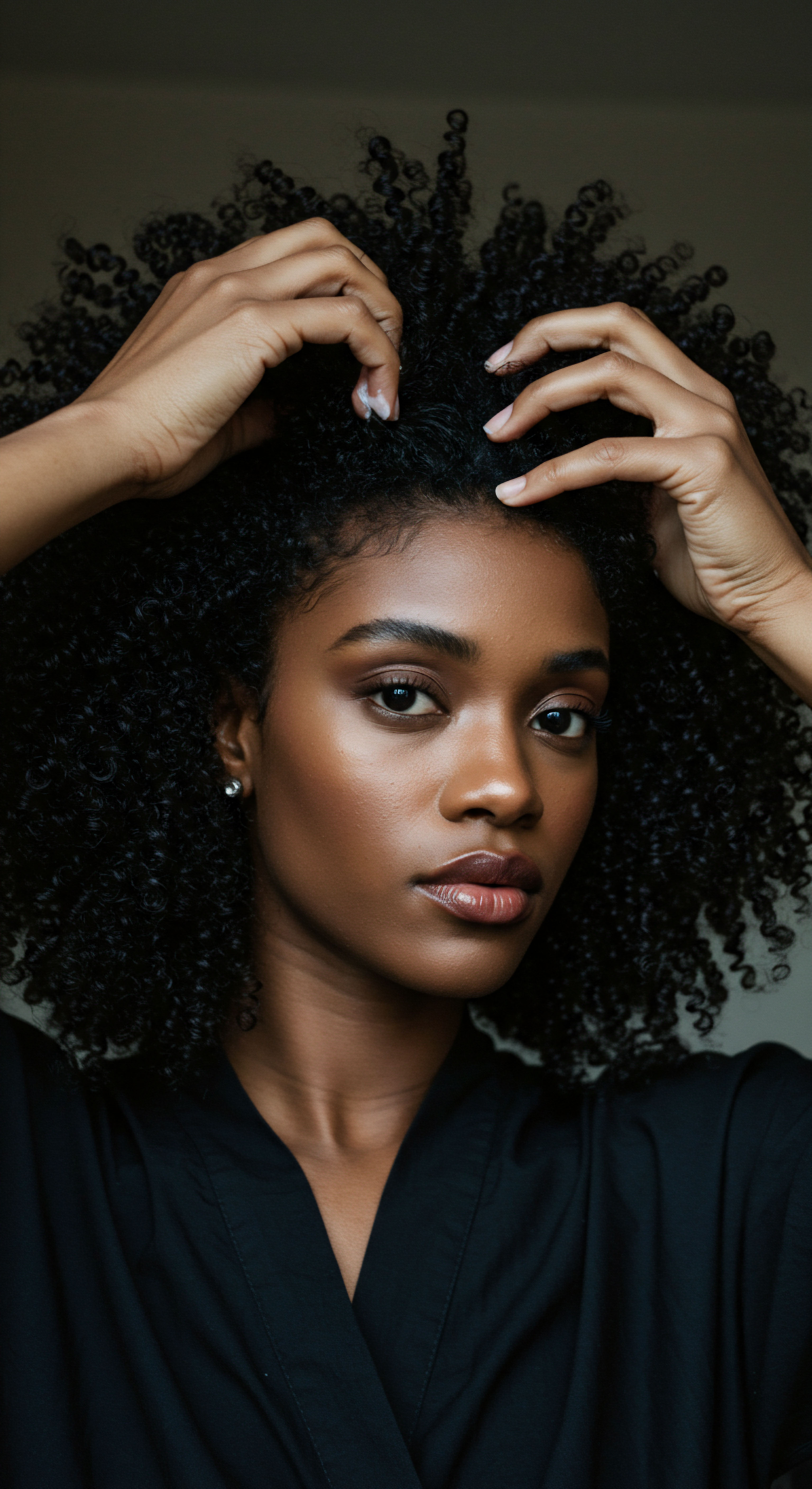
Reflection
As we draw our thoughts together, the quiet truth becomes clear ❉ the nightly descent into deep sleep is not simply a pause in our busy lives, but a profound act of renewal for our textured hair. It is a time when the body, in its wisdom, orchestrates a symphony of cellular repair and hormonal balance, all contributing to the resilience and beauty of each coily strand. The strength we seek for our hair often begins in the serene hours of undisturbed rest, a testament to the body’s inherent capacity for restoration.
The journey to truly strong, vibrant coils is a holistic one, encompassing external care and internal harmony. While we may apply the finest conditioners and practice the most gentle styling, the true magic of hair renewal often happens in the dark, under the quiet guardianship of deep sleep. May this understanding invite a deeper reverence for your rest, recognizing it as a powerful, gentle ritual for the coils you carry.

References
- Aoki, M. & Yagita, K. (2010). Noninvasive method for assessing the human circadian clock using hair follicle cells. Proceedings of the National Academy of Sciences, 107(37), 16943-16948.
- Geylikman, D. & Jimenez, J. J. (2017). Sleep and Hair Growth ❉ What’s the Connection? Journal of Cosmetics, Dermatological Sciences and Applications, 7(04), 283.
- Lin, K. K. & Yeh, C. H. (2014). Circadian Clock Genes Contribute to the Regulation of Hair Follicle Cycling. PLoS Genetics, 10(9), e1004621.
- Liu, T. & Yang, Y. (2023). Overview of the Circadian Clock in the Hair Follicle Cycle. Biomolecules, 13(7), 1068.
- Miller, R. A. & Kennedy, B. K. (2017). Clock genes, hair growth and aging. Aging, 9(4), 939–940.
- Orentreich, N. & Orentreich, D. S. (1980). Sleep deprivation decreases the beard-hair growth in man. Journal of Investigative Dermatology, 74(5), 337-338.
- Sahin, M. & Gurgen, S. (2023). Melatonin and the Human Hair Follicle. Journal of Drugs in Dermatology, 22(3), 285-290.
- Wang, J. & Zhang, H. (2023). Melatonin regulates the periodic growth of secondary hair follicles through the nuclear receptor RORα. Frontiers in Physiology, 14, 1196403.
- Yang, X. & Liu, X. (2023). Hair Follicles as a Critical Model for Monitoring the Circadian Clock. International Journal of Molecular Sciences, 24(3), 2736.
- Yoon, J. & Lee, H. J. (2020). The Effects of Sleep Deprivation on the Biophysical Properties of Facial Skin. Journal of Cosmetic Dermatology, 19(2), 346-353.